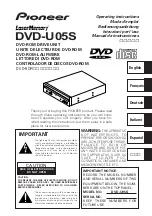
D
D
C
C
S
S
8
8
1
1
0
0
D
D
i
i
g
g
i
i
t
t
a
a
l
l
D
D
C
C
S
S
e
e
r
r
v
v
o
o
D
D
r
r
i
i
v
v
e
e
r
r
M
M
a
a
n
n
u
u
a
a
l
l
R
R
e
e
v
v
1
1
.
.
0
0
Tel: (86)755-26434369
13
Website: www.leadshine.com
along with the ground (or chassis) wire, if available.
Cable Shielding
All signal wires should be bundled and shielded separately from driver power and
motor power wires. Power wires should also be bundled and shielded. When
grounding a shield, the rule-of-thumb is to do so at the
‘
source
’
of power while
leaving the other shield end open. For example, in the case of motor power wires,
this would be the drive side. Ideally, twisted pairs should be individually shielded
and isolated from the outer shield, which encompasses all wires within the cable.
However, since this type of stringent shielding practice is often not required, typical
cables do not provide isolation between inner and outer shields.
System Grounding
Good grounding practices help reduce the majority of noise present in a system. All
common grounds within an isolated system should be tied to PE (protective earth)
through a
‘
SINGLE
’
low resistance point. Avoiding repetitive links to PE creating
ground loops, which are a frequent source of noise. Central point grounding should
also be applied to cable shielding; shields should be open on one end and grounded
on the other. Close attention should also be given to chassis wires. For example,
motors are typically supplied with a chassis wire. If this chassis wire is connected to
PE, but the motor chassis itself is attached to the machine frame, which is also
connected to PE, a ground loop will be created. Wires used for grounding should be
of a heavy gauge and as short as possible. Unused wiring should also be grounded
when safe to do so since wires left floating can act as large antennas, which
contribute to EMI.
Power Supply Connection
NEVER
connect power and ground in the wrong direction, because it will damage
the DCS810 driver. The distance between the DC power supply of the drive and the
D
D
C
C
S
S
8
8
1
1
0
0
D
D
i
i
g
g
i
i
t
t
a
a
l
l
D
D
C
C
S
S
e
e
r
r
v
v
o
o
D
D
r
r
i
i
v
v
e
e
r
r
M
M
a
a
n
n
u
u
a
a
l
l
R
R
e
e
v
v
1
1
.
.
0
0
Tel: (86)755-26434369
14
Website: www.leadshine.com
drive itself should be as short as possible since the cable between the two is a source
of noise. When the power supply lines are longer than 50 cm, a 1000
µ
F/100V
electrolytic capacitor should be connected between the terminal
“
GND
”
and the
terminal
“
+VDC
”
. This capacitor stabilizes the voltage supplied to the drive as well
as filters noise on the power supply line.
Please note that the polarity can not be
reversed.
It is recommended to have multiple drivers to share one power supply to reduce cost
if the supply has enough capacity. To avoid cross interference,
DO NOT
daisy-chain
the power supply input pins of the drivers. Instead, please connect them to power
supply separately.
5. Tuning the servo
Testing the servo
You may wish to secure the motor so it can
’
t jump off the bench. Turn on the power
supply, the green (Power) LED will light. The DCS810 has default parameters
stored in the driver. If the system has no hardware and wirings problem, the motor
should be locked and the driver should be ready.
If the motor jumps slightly and the red LED immediately turns on (flickers), then
either the motor or the encoder is wired in reversal. Open the tuning software
ProTuner and check driver status by clicking
Err_check
. If it
’
s
Phase Error
, then
reversal motor wires or exchange encoder inputs and try again. If it
’
s
Encoder
Error
, please check encoder and its wirings, and then try again. If it still doesn
’
t
work after you followed all of the previous steps, please contact us at
[email protected].
If the red LED is off and the motor is normal, then you can start to tune the servo
with selected tool.
ProTuner
,
EZ-Tuner
and
STU
are available for the DCS810.































